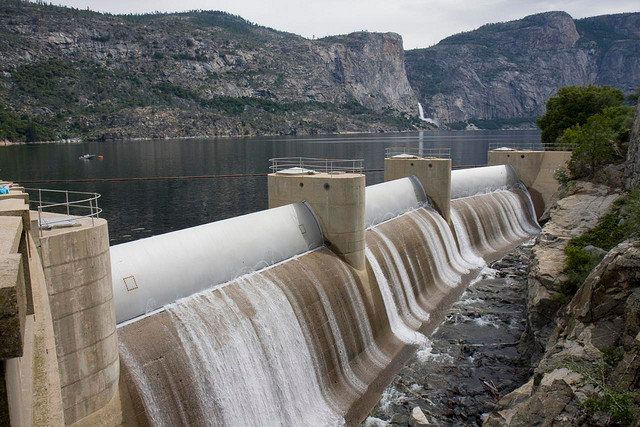
Environmentalists sometimes come in unlikely shapes.
Take Congressman Dan Lungren, for example. A Republican representing Sacramento's eastern suburbs, Lungren is about as conservative as Golden State legislators get--with a two percent lifetime rating from the League of Conservation Voters and a seven percent rating from Environment America.
Even so, Lundren is increasingly making waves with his radically green proposal to blow up the O'Shaughnessy Dam, which serves as the backbone of Yosemite National Park's Hetch Hetchy Reservoir. Destroying the dam would once again give nature-lovers the chance to experience this long-submerged piece of wild California.
Hetch Hetchy is the primary source of clean drinking water for nearly ten percent of Californians and creates hydroelectric power for millions more. The California Department of Water Resources estimated that the overall cost of destroying the dam could range from $2 billion up to $10 billion.
"If tomorrow, Disney would announce that they are going to build a second Yosemite Valley for $2 billion or $10 billion, people would marvel at it, and they'd say, 'What a great idea, to give us a sense of this beautiful valley,' " Lungren told the San Francisco Chronicle. "Well doggone it, God's already given it to us. Call me a romantic or whatever you want; if I could leave Congress having given back a valley like that for my kids and my grandkids, I'd consider that successful."
Lungren sent a letter to Interior Secretary Ken Salalzar late last year urging the federal government to investigate the San Francisco Public Utilities Commission, the group overseeing Hetch Hechy, for violations of the 1913 Raker Act, which allowed for the creation of the dam but required that the city "first draw upon their own stored water to the fullest practicable extent" before tapping into water diverted from the Tuolumne River.
"It is my belief that..the city is failing to satisfy the clear mandate of the Raker Act that all local resources be exhausted before drawing water from the Tuolumne," wrote Lungren, who went on to charge the SFPUC of insufficient efforts at harvesting rainwater and instituting a water recycling program.
Lungren's proposal has been running into stiff opposition, even in typically "green" quarters.
California Senator Diane Fienstein (League of Conservation Voters score: 88 percent) called the idea out of the question in a statement released to the Los Angeles Times. "The suggestion that San Francisco is not using its water supply efficiently is simply not true. Per person, Bay Area residents use less than half...the state's per-capita average," she wrote. "Hetch Hetchy provides critical water supplies to 2.5 million people and thousands of businesses, and any effort to jeopardize that water supply is simply unacceptable."
Lungren's largely agricultural home district has one of the highest per capita water use rates in the state.
Michael Carlin, deputy general manager of the San Francisco Public Utilities Commission, which manages the Hetch Hetchy Regional Water System, said the agency is not violating the Raker Act. He pointed to existing and planned programs aimed at cultivating alternative water sources.
Carlin said SFPUC uses about six million gallons of recycled water a day in communities outside the city; about 1.5 million gallons of groundwater for irrigation, including in Golden Gate Park; and is developing a program to use groundwater for drinking.
Lungran has been pushing this idea for years but has consistently failed to gain serious traction. The Bay Citizen reports:
Lungren endorsed a 2008 federal proposal to spend $7 million to study the feasibility of restoring Hetch Hetchy Valley, the Times reported. "The idea didn't get anywhere," Lungren told the newspaper. "I got the strongest impression it was stonewalled by the strongest powers in the House."
If Hetch Hechy really does close, the most likely alternative would be to expand the Don Pedro Dam to divert water from Tuolumne further from its source high in the Sierras. Right now, the SFPUC uses Don Pedro solely as a "water bank" to repay the water it takes from the Turlock and Modesto Irrigation Districts.
A 2007 report by the Environmental Defense Fund found that in four out of five years the SFPUC could meet its water needs under this program; however, in the driest years, a small amount of additional water would be needed from elsewhere in the state's water system.
Another problem noted in the report is that the SFPUC doesn't have an infrastructure to bring water from Don Pedro down to the coastal regions where its needed and, at present, nor does the commission have the legal rights to build such an infrastructure.
Famed naturalist John Muir called Hetch Hetchy Valley, with its high granite cliffs and cascading waterfalls, Yosemite's "wonderfully exact counterpart...a grand landscape garden, one of Nature's rarest and most precious mountain temples." Congress officially protected the Hetch Hetchy Valley from development in 1890 but, only a few short decades later, reversed its decision and allowed the valley to be flooded.
The O'Shaughnessy Dam is the only large dam in the nation to be installed inside a national park.
